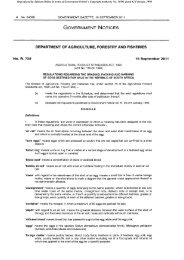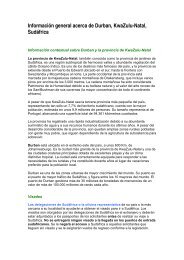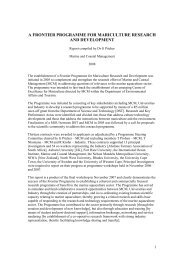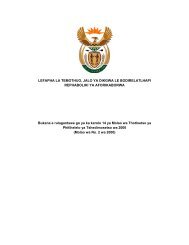You also want an ePaper? Increase the reach of your titles
YUMPU automatically turns print PDFs into web optimized ePapers that Google loves.
S<br />
tarfish, or sea stars, belong to the phylum<br />
Echinodermata, which also includes the<br />
brittlestars, feather stars, sea urchins and sea<br />
cucumbers. Starfish are star-shaped and usually<br />
have five arms and hundreds of delicate tube feet<br />
with suckered tips. The five-armed arrangement is<br />
stronger than four or six because the animal is less<br />
likely to be pulled in half if attacked. Starfish can<br />
regrow an arm if one is ripped off: in fact a single<br />
arm can regenerate a whole new body. The skeleton<br />
of a starfish is a mosaic of knobbled plates held<br />
together with elastic fibres and imbedded in the<br />
skin. These plates grow with the animal so the<br />
starfish does not have to moult. In many starfish<br />
the skin is dotted with tiny three-jawed structures<br />
(pedicellaria) which snap at creatures that attempt<br />
to settle on them. As a result, creatures such as<br />
barnacles and seaweeds are not found growing on<br />
the backs of starfish.<br />
Sea water for blood<br />
Starfish have a water vascular system. A tube filled with sea<br />
water circles the gut and sends a canal down each arm.<br />
Water enters the tube through a sieve plate on the upper<br />
surface, allowing the starfish to equalise the water pressure<br />
inside the body with any changes in pressure outside, such<br />
as those caused by the rise and fall of the tide. Tiny gills<br />
connect with this water-vascular system and project from the<br />
surface of the starfish. Through these simple tubes, oxygen<br />
is absorbed and waste carbon dioxide released into the<br />
seawater during respiration.<br />
tube feet<br />
red gills<br />
C O A S TA L A N D M A R I N E L I F E – A N I M A L S : I N V E RT E B R A T E S – E C H I N O D E R M S<br />
Starfish 3B<br />
Spines surrounded by<br />
pedicellaria<br />
sieve plate<br />
Spiny starfish<br />
Walking on water<br />
Starfish can take off in any direction, guided by a sense organ<br />
at the tip of each arm that can ‘taste’ and is sensitive to light.<br />
They have a hydraulic system of locomotion. On the lower<br />
surface of the body rows of tube feet occur in ambulacral<br />
grooves that extend from the central mouth to the tips of the<br />
arms. Tube feet connect with the water vascular canals and<br />
extend or shorten as water is pumped into or out of them. The<br />
starfish doesn’t ‘bleed’ to death if the tube feet are damaged<br />
because tiny valves can close off parts of the system. The<br />
tube feet end in suckers that grip the substrate and enable<br />
the starfish to creep along slowly.<br />
Feeding<br />
The mouth is on the underside and the anus on the topside.<br />
When starfish feed they turn their stomachs inside out and<br />
release enzymes externally to digest the food! Many of them<br />
(such as cushion stars) are herbivorous or feed on seaweed<br />
sporelings or scum on the rocks (e.g. cushion stars). Others<br />
such as the spiny starfish, Marthasterias glacialis a re, however,<br />
carnivorous and can feed on sessile or slow-moving animals<br />
such as red bait, molluscs, sponges or corals. It may take<br />
several hours for a starfish to pull a mussel apart and slowly<br />
digest it.<br />
Reproduction<br />
Starfish reproduce sexually. Most release large numbers of<br />
tiny eggs and sperm into the water where fertilisation occurs.<br />
The eggs develop into transparent larvae that float in the<br />
plankton. The larvae are bilaterally symmetrical (with similar<br />
left and right sides) and only become star-shaped when<br />
adult. Some starfish (e.g. cushion stars) do not have larvae<br />
but brood their eggs in the body until miniature adults wriggle<br />
free, whereas others lay eggs that hatch directly into adults.<br />
sense organ<br />
arms with bands of hairs<br />
Bilateral, transparent<br />
larva of starfish<br />
(magnified)
















